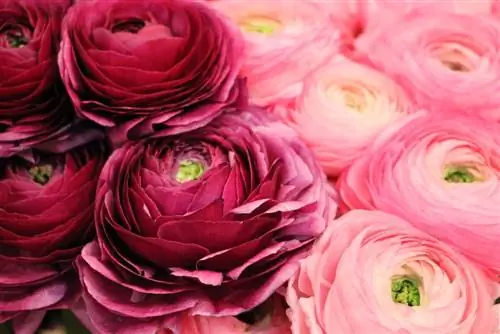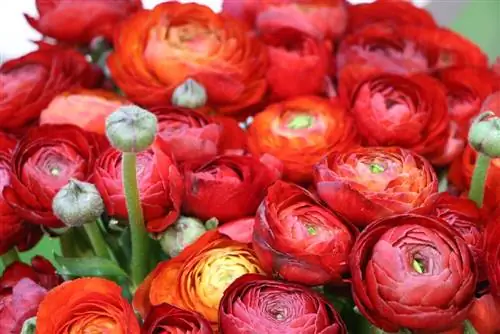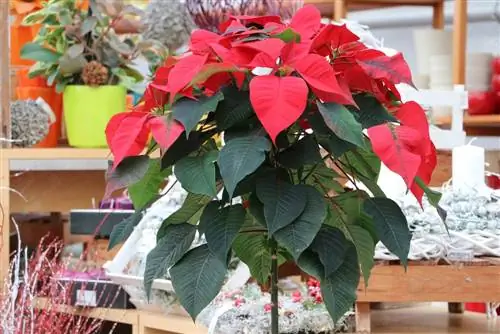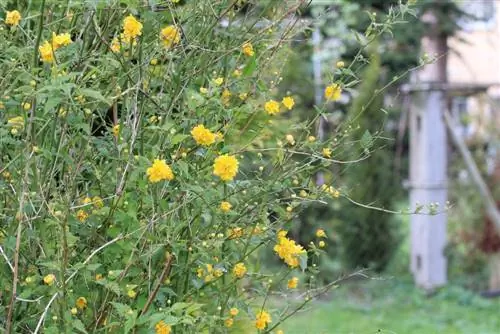- Author admin [email protected].
- Public 2023-12-17 03:39.
- Last modified 2025-01-24 12:45.
When the ranunculus drops its leaves after flowering, then it is time to plan the overwintering of the sensitive plant. Since the perennial flowers are only partially hardy, they rely on additional protective measures in the winter months. Without this winter protection, the plants can freeze to death in severe and prolonged frosts. As an alternative, the root tubers can spend the winter in a frost-free place.
Winter hardiness
The distinctive flowers come from Asia and are not used to the local temperatures and deep frost due to their origin. That's why outdoor ranunculus can only remain outside undamaged in winter if the location is not too cold and exposed. At extreme altitudes with low temperatures, prolonged frost would damage the plants. In extreme cases, the flowers and their roots can even freeze. Therefore, it is generally safer to dig up the tubers and overwinter in a frost-free place.
- They are poorly hardy
- Wintering is only possible in mild regions
- This includes the German wine-growing regions and protected valleys
- It is essential to protect bulbous plants from frost
- Apply a warm blanket made of brushwood or compost
- In extremely cold regions, additionally lay out garden fleece
Overwinter tubers
Some of the ranunculus varieties are already somewhat used to the local winter due to local breeding and score points with their better winter hardiness. However, if you don't want to take any risks, you should bring in the tubers. The right time period and suitable preparation play an important role. When choosing the time period, you should pay attention to the weather forecast in order to accommodate the bulbous structures in good time. When the temperature levels reach a critical point, it is time to move the ranunculus bulbs. With appropriate preparation for overwintering, the tubers can survive the winter months outside the ground without any problems.
- Critical temperature values are around 5° C during the day
- Ideally get the tubers out of the ground around mid-October
- Set fertilizer first
- Then remove all dead parts above ground
- Then dig up carefully
- Clean from any soil residue
- Carefully separate brood tubers
- Let the tubers dry sufficiently
- Wrap in plain paper or newspaper for extra protection
Winter quarters

Especially if the ranunculus are grown in planters on the balcony or terrace, they need a suitable place to overwinter. But free-range plants also benefit from moving to adequate winter quarters. To do this, the ranunculus tubers must be removed from the ground and stored in a place protected from frost. There the tubers are put into a winter rest mode. These no longer sprout, but are in a resting phase. The following spring the root tubers are brought back to life.
- Unheated cellars, garages or attics are ideal
- Rooms must be cool but completely frost-free
- Dark, airy and dry
- Optimal temperature values are between 5-8° C
Aftercare
After overwintering, the tubers need special aftercare so that they can settle again in the soil or planter without any problems. In this way, the ranunculus is carefully brought back to life. However, no more hard frosts should be expected, only then can the tubers move back outside. This point in time is significantly later in higher mountain altitudes than in protected regions with a mild climate.
- Overwintering should last until March or April
- Check tubers for possible damage
- Put in container with cool water for about 5 hours
- Then dig 3-4 cm deep into the soil
- Only fertilize when the first leaves are visible
Repotting & Moving
If the ranunculus remains in the same location consistently and for many years, then it's time to implement it. In this way, the soil can recover and replenish the nutrients that have been used up until then. Since the tubers are brought into the house in the fall anyway, the move can be carried out in this context. If the location is still relatively new, the tubers can be replanted in the same places in spring. This should also be done when keeping pots and containers, as the plant substrate will eventually be exhausted.
- Ideally transplant tubers every two to four years
- Choose a new location with nutrient-rich soil
- Cool and moist soil is important
- Tolerates both partial shade and sunny lighting conditions
- Proceed similarly with ranunculus in flower pots and containers
- Change plant substrate every few years
- Always pay attention to permeable substrate
- If there are numerous breeding tubers, moving to larger pots is necessary
Propagate

The ranunculus multiply on its own, so this process is very easy to carry out. Propagation can also be carried out during overwintering, as the distinctive flowering plants normally produce breeding tubers over the course of the year. These form themselves as offshoots on the mother tubers of the ranunculus. For propagation, the breeding bulbs simply need to be removed when moving the bulbs. This type of propagation is possible all year round as soon as new tubers appear.
- Small and very sharp knife is ideal for cutting
- Apply pressure carefully and lightly
- Mother and brood tubers must not be damaged
- Prefer indoors in winter
- Direct planting outdoors is possible at the beginning of spring






